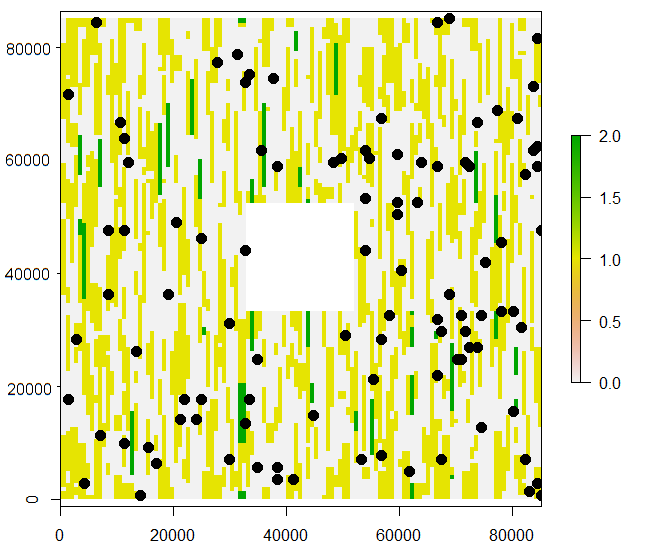Using computer models to understand and forecast reinvasion by invasive mammals

Juvenile ferret. © Grant Morriss
Preventing and effectively managing reinvasions is essential for the long-term viability and success of invasive species eradication and control interventions. It is a particularly formidable challenge in mainland scenarios where there are no natural barriers to hamper the spread and movement of potential reinvaders. The factors determining reinvasion pressure, measured as the total number of animals arriving in a managed area per year, and how managers better overcome the issues posed by such reinvasions, are the focus of ongoing research by Pablo Garcia-Diaz and Grant Norbury, in collaboration with other personnel from the Wildlife Ecology and Management team.
The complexity of the problem and the lack of information on the topic meant that a relatively simple modelling exercise would be a suitable starting point. Pablo and Grant developed a ‘simulation’ computer model, a simplified representation of reality that functions like a game, where animals move around a virtual landscape following rules set by the researchers. By repeating the model multiple times (playing multiple games) using different values, it is possible to explore how reinvasion pressure responds to a range of potential virtual realities and how it depends on the settings established by the researchers. This approach will identify the most likely factors driving reinvasion pressure, and highlights knowledge gaps that need to be addressed to effectively manage reinvasions.
Pablo and Grant developed a proof-of-concept modelling framework, which they applied to a case study of reinvasion by juvenile feral ferrets in a large landscape (720 000 ha). In the middle of the landscape they included a large area (33 500 ha) where ferrets had been eradicated and kept free of reinvaders. The remaining landscape was divided into habitat patches where ferrets lived – patches that were the potential sources of reinvaders. The model specified that juvenile ferrets would disperse from these patches and move across the landscape. The position of each dispersing juvenile ferret in the landscape was monitored for 120 days, and whenever a ferret arrived in the eradicated block it was scored as a reinvasion event. Two hundred repetitions of the model were undertaken, which took approximately 5 hours on a standard laptop computer. The modelling results showed very clearly that reinvasion pressure on the area cleared of ferrets was very high in the absence of management, and that reinvading ferrets were most likely to have come from those habitat patches closest to the eradicated block that harboured a high number of ferrets.

The model can be used to narrow down the number of unknown ecological variables needed to design appropriate fieldwork to obtain good information to update the model and make it more realistic and tailored to the particular context where intervention will take place. The first batch of model outputs will be used to guide field research, and the data will then be fed back into the model. Another batch of model runs will allow researchers to refine their recommendations for managing reinvasion pressure at landscape scales. Preliminary results clearly show that managing reinvasion pressure requires a landscape-level perspective that explicitly considers invasive mammals in the surrounding area. This updated model will be used to explore management alternatives and suggest cost-effective interventions to better tackle the risk of reinvasion.
Given that the same general principles of reinvasion ecology apply across most inland systems, this approach is likely to be beneficial for a range of invasive species management projects. In the short term, Pablo and Grant aim to include other species (e.g. stoats) in their model to see whether the same interventions can tackle multiple species simultaneously, or whether it is necessary to adapt separate management strategies for each targeted species.
More broadly, the example reported here showcases the power of modelling for tackling complex ecological problems. The process is to (1) begin by developing a simple, yet realistic, computer model to explore the processes underlying the problem, (2) use the outputs of the model to inform subsequent fieldwork and data collection to quantify the most sensitive ecological parameters, and, (3) revise the model using these newly acquired data to improve the reliability of the model predictions.
This work was funded by the Strategic Science Investment Fund provided by the New Zealand Ministry of Business, Innovation and Employment.
Pablo Garcia-Diaz
Garcia-DiazP@landcareresearch.co.nz
Grant Norbury
